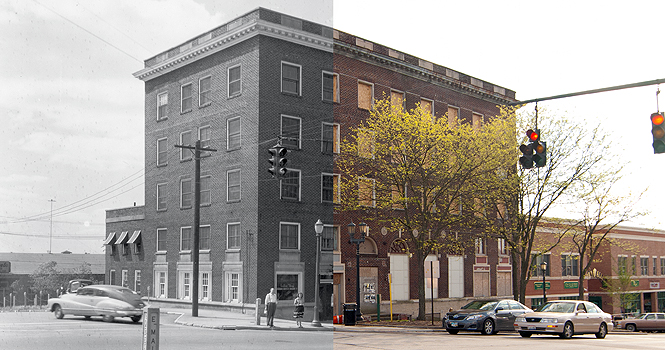Kent seeks historic preservation in time of development
April 16, 2012
See related story here.
In the past few years, millions of dollars have been spent on downtown development, but what most people don’t realize is a significant amount of money has been spent in hope nobody notices.
The city of Kent has worked hard to create a delicate balance between new development and historic preservation. The key to character, said Dan Smith, economic development director, is honoring the city’s heritage in the midst of new development.
“We don’t want to be a whitewash community by just coming in and razing everything and putting new buildings in its place,” Smith said.
At one point, Smith said, there was a development plan that showed the Pufferbelly Restaurant being torn down and the space being used for a new parking lot.
“I just think it would have been tragic to lose what’s a wonderfully architecturally significant building and piece of our heritage and used for a parking lot,” Smith said.
The city has heard concerns from property owners wondering if the historic preservation efforts of the city will result in higher costs to renovate personal property so that it fits within the guidelines of downtown.
“We’ve had questions like that, but far fewer than questions like how did we just let the Robin Hood building be demolished,” Smith said.
When the Robin Hood was demolished, he said, there were no guidelines in place. All that was needed to demolish was a permit, but now the city must do a review before a demo permit is issued.
After losing the Robin Hood, Kent residents were not willing to lose another landmark, the Franklin hotel. Ron Burbick, a retired businessman and developer, adopted Kent as his hometown and was willing to lead the charge to save the old Franklin Hotel.
“[Burbick] certainly has the preservation bug,” Smith said.
For Burbick, giving back to the community was a no-brainer.
A Kent resident for nearly 40 years, Burbick owned Schneller, a company that manufactures airplane interiors. After a large fire at his company in the 1980s, he said he saw just how large the generosity of the city of Kent was, when several downtown businesses let him use office space at no cost.
After selling Schneller five years ago, Burbick saw it as time to give back.
“I had spent my time making money, now it was my turn to make a difference,” he said.
Kent residents have seen the difference Burbick has made in the forms of Acorn Alley I and II. His latest project, renovating the old Franklin Hotel, seeks to blend the past with the future.
“[Burbick] has been a local businessman for many years, so he is certainly engaged in the legacy of the central business district,” Smith said. “Now he can reshape it to serve residents and visitors in the future.”
Tom Hatch, director of the Kent Historical Society, said that in order to justify having a historic building, that building must have a future use and be sustainable and affordable to rehabilitate.
“I think it’s important to keep buildings around that enable us to tell the history of our community and pass on that knowledge,” Hatch said.
While demolishing the hotel located at the corner of South Depeyster and East Main Street and building something similar to Acorn Alley would have cost half the money, Burbick said the historical integrity of the building made it worth saving.
“To me it’s always been a classic building, but something needed to be done with it,” he said.
And that something will not be cheap. Burbick estimated the renovation of the hotel would cost around $5.1 million, but its designation as a historical landmark will likely help. He said they have applied to receive state and federal historical credits that will likely give them about $1.8 million if they receive them.
Burbick’s own company and Buffalo Wild Wings, which will be the main tenant of the building, have each given more than $1 million. Burbick said he expects that donations from a few people in the community will cover the rest.
Work has already begun on the interior of the building, and Burbick said he expects it to be finished by the beginning of December.
Burbick said renovating the hotel is all part of blending Kent’s history with its new development.
Tom Euclide, the associate vice president of facilities planning and operations for Kent State, said the development plans for the city have always aimed at keeping the character of Kent.
“We wanted to keep the flavor of downtown,” he said. “[A new building] doesn’t have to be designed historically, but it should echo the type of architecture that was used in the old town.”
Euclide said the development plans at the various sites downtown have had to be altered to prevent them from looking too modern.
“What you don’t want to do in a downtown development is have a new street and an old street,” he said.
In the course of the Esplanade Expansion, Euclide said Kent State has run into a few houses that have historic value, the main one being the May Prentice house, which was the home of the first female faculty member of Kent State.
Instead of demolishing it, the university spent $30,000 to move it to another location. Euclide said that the use for the house once it is renovated has not been decided yet, but it will likely not be used for academic purposes.
Another house that may be spared from demolition is the Wells-Sherman house. While this home has no ties to the university, it is an important part of the city’s history. Euclide said the university would do what it can to help the people interested in saving it.
Contact Rabab Al-Sharif at [email protected] and Meghan Bogardus at [email protected].












